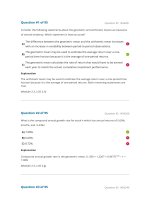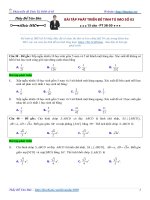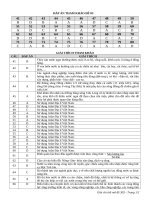Chapter 03 network layer and IP
Bạn đang xem bản rút gọn của tài liệu. Xem và tải ngay bản đầy đủ của tài liệu tại đây (2.3 MB, 24 trang )
Contents
Chapter 3: Network Layer and IP
Address
Network Layer
IP Address
3.1 Introduction
3.2 Internet Protocol
Datagram format
IPv4 addressing
DHCP, NAT, ARP
ICMP
IPv6
3.3 Routing algorithms
Link state
Distance Vector
Hierarchical routing
3.4 Routing in the
Internet
RIP
OSPF
BGP
4-2
How TCP/IP works …
Network layer
segment
datagram
transport segment from sending
to receiving host
on sending side encapsulates
segments into datagrams
on rcving side, delivers
segments to transport layer
application
transport
network
data link
physical
network
data link
physical
network layer protocols in every
host, router
network
data link
physical
network
data link
physical
network
data link
physical
network
data link
physical
network
network
data link
data link
physical
physical
network
data link
physical
router examines header fields
in all IP datagrams passing
through it.
network
data link
physical
network
data link
physical
network
data link
physical
application
transport
network
data link
physical
4-4
1
Interplay between routing and forwarding
Two Key Network-Layer Functions
routing algorithm
forwarding: move packets from
router’s input to appropriate router
output
local forwarding table
header value output link
0100
0101
0111
1001
routing: determine route taken by
packets from source to dest.
routing
3
2
2
1
value in arriving
packet’s header
algorithms
0111
1
3 2
Datagram networks
Forwarding table
no call setup at network layer
routers: no state about end-to-end connections
packets forwarded using destination host address
Destination Address Range
no network-level concept of “connection”
packets between same source-dest pair may take different paths
application
transport
network
data link 1. Send data
physical
application
transport
2. Receive data network
data link
physical
4 billion
possible entries
Link Interface
11001000 00010111 00010000 00000000
through
11001000 00010111 00010111 11111111
0
11001000 00010111 00011000 00000000
through
11001000 00010111 00011000 11111111
1
11001000 00010111 00011001 00000000
through
11001000 00010111 00011111 11111111
2
otherwise
3
4-7
2
Longest prefix matching
Prefix Match
11001000 00010111 00010
11001000 00010111 00011000
11001000 00010111 00011
otherwise
Contents
Link Interface
0
1
2
3
3.1 Introduction
3.2 Internet Protocol
Examples
DA: 11001000 00010111 00010110 10100001
DA: 11001000 00010111 00011000 10101010
Which interface?
Which interface?
Datagram format
IPv4 addressing
DHCP, NAT, ARP
ICMP
IPv6
3.3 Routing algorithms
Link state
Distance Vector
Hierarchical routing
3.4 Routing in the
Internet
RIP
OSPF
BGP
4-10
The Internet Network layer
Host, router network layer functions:
Transport layer: TCP, UDP
Network
layer
IP protocol
•addressing conventions
•datagram format
•packet handling conventions
Routing protocols
•path selection
•RIP, OSPF, BGP
forwarding
table
IP – Internet Protocol
IP is the main protocol of the TCP/IP protocol
suite.
Data packet is transmitted as a datagram.
IP provides an unreliable, connectionless
datagram delivery service.
ICMP protocol
•error reporting
•router “signaling”
Link layer
physical layer
3
IP - Datagram delivery service
Unreliable:
Review: Connectionless vs.
Connection-oriented Protocols
guarantees that an IP datagram successfully
gets to its destination.
Provides a best effort service.
Reliability must be provided by the upper layers
(e.g., TCP).
Send data across the network to its destination
without guaranteeing receipt
Fast; require little overhead
No
Connectionless:
not
maintain any state information about
successive datagrams.
IP datagrams can get delivered out of order.
Connectionless protocols
Connection-oriented protocols
Establish a formal connection between two
computers, guaranteeing the data will reach its
destination
Slower; more reliable
IP datagram format
IP Datagram
IP protocol version
number
header length
(bytes)
“type” of data
max number
remaining hops
(decremented at
each router)
Header
10101011101010101010010101010100101010100
11010010101010010101111111010000011101111
10100001011101010100110101011110100000101
00100000000010101000011010000111111010101
......... 1011011001010100011001001010110
Data
upper layer protocol
to deliver payload to
how much overhead
with TCP?
20 bytes of TCP
20 bytes of IP
= 40 bytes + app
layer overhead
32 bits
type of
ver head.
len service
16-bit identifier
upper
time to
layer
live
flgs
total datagram
length (bytes)
length
fragment
offset
header
checksum
for
fragmentation/
reassembly
32 bit source IP address
32 bit destination IP address
Options (if any)
data
(variable length,
typically a TCP
or UDP segment)
E.g. timestamp,
record route
taken, specify
list of routers
to visit.
4
IP Address
IP Addressing: introduction
IP address: 32-bit
identifier for host,
router interface
interface: connection
between host/router
and physical link
223.1.1.1
223.1.1.2
223.1.1.4
223.1.1.3
223.1.2.1
223.1.2.9
223.1.2.2
223.1.3.27
router’s typically have
multiple interfaces
host typically has one
interface
IP addresses associated
223.1.1.1 = 11011111 00000001 00000001 00000001
with each interface
IPv4: 32-bits
IPv6: 128-bits
223.1.3.2
223.1.3.1
223
Version:
1
Addressing and Delivering
1
1
IPv4
Size: 4 bytes (32 bits)
Format:
— Each byte is represented by a decimal number,
called a octet
— two octets separated by a dot “.”
Example:
10101100.00011101.00000001.00001010
172.29.1.10
Divided into 2 parts:
Network ID (NetID)
Host ID
5
IPv4
IPv4
Subnet mask:
Use to identify the NetID and HostID parts of
the IPv4 address
4 bytes in size
NetID
bits have a value of 1
bits have a value of 0
HostID
IPv4
IPv4
NetAddr = SubnetMask AND HostIP
Network address (NetAddr):
Example: 172.29.5.128/255.255.192.0
(or 172.29.5.128/18)
HostIP 1010 1100 0001 1101 0000 0101
Subne
1111 1111 1111 1111 1100 0000
tMask
Net
1010 1100 0001 1101 0000 0000
Addr
0000 0000
0000 0000
Broadcast address:
1000 0000
NetID bits: keep the same
Host ID bits: up 1
Example: 192.168.1.2/24
NetID bits: keep the same
Host ID bits: clear to 0
NetAddr: 192.168.1.0
Broadcast: 192.168.1.255
Two nodes with the same network address belong to same network:
Example:
192.168.1.2 and 192.168.1.200: same network
192.168.1.2 and 192.168.2.1: different network
6
IPv4
IPv4: class
Number of valid host addresses in a network:
2^m-2: m is the number of bits in the HostID
Host addresses range:
(Network address + 1) -> (Broadcast address –
1)
Example: 172.29.1.1/16
=>m = 32-SM=32-16
=>Number of hosts in this network = 2^16-2
IPv4: class
IPv4:
Default subnet mask:
Class
A: 255.0.0.0 (/8)
B: 255.255.0.0 (/16)
Class C: 255.255.255.0 (/24)
Class
Example: 15.19.18.29
Class: A
Default
Subnet mask: 255.0.0.0
7
IPv4:
IPv4: Exercise
For IP address: 172.29.7.10
Class: B
SubnetMask: 255.255.0.0 (/16)
NetAddr = IP address AND SubnetMask
172.29.7.10 AND
For IP address: 191.24.197.12/20
Class:
?
SubnetMask:
?
NetAddr
:?
of hosts in the network: ?
Host addresses range: ?
Broadcast address: ?
Number
255.255.0.0
172.29.0.0
Number of hosts in the network: 2^m-2=2^16-2
Host addresses range: 172.29.0.1->172.29.255.254
Broadcast address: 172.29.1111 1111. 1111 1111
IPv4: Public address Vs. Private
IPv4: Classify
Public address:
Used to exchange on the Internet
Real address
Private address:
address
Used to address LANs within an organization
Virtual Address
Clas
s
Address (range)
Network
s
Total Private
Hosts
A
10.0.0.0
1
16,777,214
B
172.16.0.0-172.31.0.0
16
1,048,544
C
192.168.0.0-192.168.255.0
256
65,024
Loopback address: 127.0.0.0 – 127.255.255.255
8
IPv4: Subnetting
Reasons for subnetting:
the number of nodes => Increase
network throughput
Increased security
Ease of administration
Ease of maintenance
Avoid wasting IP addresses
IPv4: Subnetting
Reduce
Rule:
Borrow
the first bits in HostID => NetID
of subnets = 2^n (n: number of bits
borrowed from HostID)
New Subnet Mask = SM + n
Number
Planning:
(1)
Number of subnets to divide <=2^n, =>n=?
Number of nodes in each subnet <=2^m – 2,
=>n=?
(2)
IPv4: Subnetting
IPv4: Subnetting
A company is granted the site address
192.168.1.0 The company needs 5 subnets.
Design the subnets:
+ The number of the appropriate subnets?
+ The number of Hosts in each subnet?
+ New Subnet Mask?
+ Host addresses range of each subnet?
+ Broadcast address of each subnet?
192.168.1.0/SM
Class: C (N.N.N.H), =>SM=24
+ The number of the appropriate subnets:
5 subnets <=2^n, => n=3 (n: number of bits borrowed from
HostID)
The number of the appropriate subnets: 2^3 = 8
+ The number of Hosts in each subnet:
m is the number of bits in the HostID: m= (32-24) – 3 = 5
The number of Hosts in each subnet: 2^m – 2 = 2^5 – 2 =
30
+ New Subnet Mask?
NewSM=SM+n=24+3=27
255.255.255.1110 0000 <=> 255.255.255.224
9
IPv4: Subnetting
IPv4: Subnetting
+ Host addresses range of each subnet?
192.168.1.xxxh hhhh
+ Host addresses range of each subnet?
192.168.1.0110 0000 : 192.168.1.96 (Subnet No.4)
192.168.1.0000 0000 : 192.168.1.0 (Subnet No.1)
Host range: 192.168.1.1 - > 192.168.1.30
Host range: 192.168.1.97 - > 192.168.1.126
Broadcast: 192.168.1. 0111 1111 : 192.168.1.127
Broadcast: 192.168.1.0001 1111 : 192.168.1.31
192.168.1.0010 0000 : 192.168.1.32 (Subnet No.2)
Host range: 192.168.1.33 - > 192.168.1.62
192.168.1.1000 0000 : 192.168.1.128 (Subnet No.5)
Host range: 192.168.1.129 - > 192.168.1.158
Broadcast: 192.168.1.0011 1111 : 192.168.1.63
Broadcast: 192.168.1. 1001 1111 : 192.168.1.159
192.168.1.0100 0000 : 192.168.1.64 (Subnet No.3)
192.168.1.1010 0000
Host range: 192.168.1.65 - > 192.168.1.94
Broadcast: 192.168.1. 0101 1111 : 192.168.1.95
192.168.1.1100 0000
192.168.1.1110 0000
IPv4: Subnetting
IPv4: Homework
Exercise: A company is granted the site
address 172.29.0.0/18. The company needs 5
subnets. Design the subnets:
+ The number of the appropriate subnets?
+ The number of Hosts in each subnet?
+ New Subnet Mask?
+ Host addresses range of each subnet?
+ Broadcast address of each subnet?
Given 172.100.112.4/19. Please indicate:
1. Which network does the above address belong to?
2. The number of IP addresses that can be used in the network. And please tell me
which addresses include?
3. Broadcast address of that network.
4. With the above network address, divide it into 5 subnets.
+ The number of the appropriate subnets?
+ The number of Hosts in each subnet?
+ New Subnet Mask?
+ Host addresses range of each subnet?
+ Broadcast address of each subnet?
10
IP addresses: how to get one?
Goal: allow host to dynamically obtain its IP address from network
server when it joins network
Q: How does a host get IP address?
hard-coded by system admin in a file
Windows: control-panel->network->configuration>tcp/ip->properties
UNIX: /etc/rc.config
DHCP: Dynamic Host Configuration Protocol: dynamically
get address from as server
“plug-and-play”
223.1.1.2
223.1.1.4
223.1.3.1
host broadcasts “DHCP discover” msg
DHCP server responds with “DHCP offer” msg
host requests IP address: “DHCP request” msg
DHCP server sends address: “DHCP ack” msg
local network
(e.g., home network)
10.0.0/24
10.0.0.1
10.0.0.4
223.1.2.9
B
223.1.1.3
DHCP overview:
rest of
Internet
223.1.2.1
DHCP
server
Can renew its lease on address in use
Allows reuse of addresses (only hold address while connected an “on”)
Support for mobile users who want to join network (more shortly)
NAT: Network Address Translation
DHCP client-server scenario
A 223.1.1.1
DHCP: Dynamic Host Configuration Protocol
223.1.3.27
223.1.2.2
223.1.3.2
10.0.0.2
138.76.29.7
E
arriving DHCP
client needs
address in this
network
10.0.0.3
All datagrams leaving local
network have same single source
NAT IP address: 138.76.29.7,
different source port numbers
Datagrams with source or
destination in this network
have 10.0.0/24 address for
source, destination (as usual)
11
NAT: Network Address Translation
NAT: Network Address Translation
Motivation: local network uses just one IP address as far as
outside world is concerned:
range
of addresses not needed from ISP: just one
IP address for all devices
can change addresses of devices in local network
without notifying outside world
can change ISP without changing addresses of
devices in local network
devices inside local net not explicitly addressable,
visible by outside world (a security plus).
ARP: Address Resolution Protocol
2: NAT router
changes datagram
source addr from
10.0.0.1, 3345 to
138.76.29.7, 5001,
updates table
2
RARP
48-bit Ethernet Address
S: 10.0.0.1, 3345
D: 128.119.40.186, 80
S: 138.76.29.7, 5001
D: 128.119.40.186, 80
S: 128.119.40.186, 80
D: 138.76.29.7, 5001
3: Reply arrives
dest. address:
138.76.29.7, 5001
3
1
10.0.0.4
S: 128.119.40.186, 80
D: 10.0.0.1, 3345
10.0.0.1
10.0.0.2
4
10.0.0.3
4: NAT router
changes datagram
dest addr from
138.76.29.7, 5001 to 10.0.0.1, 3345
RARP: Reverse Address
Resolution Protocol
ARP
1: host 10.0.0.1
sends datagram to
128.119.40.186, 80
138.76.29.7, 5001 10.0.0.1, 3345
……
……
138.76.29.7
32-bit Internet Address
NAT translation table
WAN side addr
LAN side addr
RARP = Reverse ARP.
RARP is the opposite of ARP.
ARP is used when the IP address is known but
the physical address is not known.
RARP is used when the physical address is
known but the IP address is not known.
RARP is often used in conjunction with the
BOOTP protocol (boot PROM) to boot diskless
workstations.
12
ICMP - Internet Control Message
Protocol
Data sent to a remote computer often travels
through one or more routers.
These routers can encounter a number of problems
in sending the message to its ultimate destination.
Routers use Internet Control Message Protocol
(ICMP) messages to notify the source IP of these
problems.
ICMP is also used for other diagnosis and
troubleshooting functions.
ICMP messages encapsulated within an IP
datagram.
IPv6 Header (Cont)
Priority: identify priority among datagrams in flow
Flow Label: identify datagrams in same “flow.”
(concept of“flow” not well defined).
Next header: identify upper layer protocol for data
IPv6
Initial motivation: 32-bit address space soon to
be completely allocated.
Additional motivation:
header
format helps speed processing/forwarding
header changes to facilitate QoS
IPv6 datagram format:
fixed-length 40 byte header
no fragmentation allowed
Contents
3.1 Introduction
3.2 Internet Protocol
Datagram format
IPv4 addressing
DHCP, NAT, ARP
ICMP
IPv6
3.3 Routing algorithms
Link state
Distance Vector
Hierarchical routing
3.4 Routing in the
Internet
RIP
OSPF
BGP
4-52
13
Interplay between routing, forwarding
Graph abstraction
5
routing algorithm
2
local forwarding table
header value output link
0100
0101
0111
1001
v
u
3
2
2
1
2
1
Graph: G = (N,E)
x
3
w
3
1
5
z
1
2
y
N = set of routers = { u, v, w, x, y, z }
value in arriving
packet’s header
E = set of links ={ (u,v), (u,x), (v,x), (v,w), (x,w), (x,y), (w,y), (w,z), (y,z) }
1
0111
Remark: Graph abstraction is useful in other network contexts
3 2
Example: P2P, where N is set of peers and E is set of TCP connections
Graph abstraction: costs
5
2
u
v
2
1
x
• c(x,x’) = cost of link (x,x’)
3
w
3
1
5
z
1
y
- e.g., c(w,z) = 5
2
• cost could always be 1, or
inversely related to bandwidth,
or inversely related to
congestion
Cost of path (x1, x2, x3,…, xp) = c(x1,x2) + c(x2,x3) + … + c(xp-1,xp)
Question: What’s the least-cost path between u and z ?
Routing algorithm: algorithm that finds least-cost path
Routing Algorithm classification
Global or decentralized
information?
Global:
all routers have complete
topology, link cost info
“link state” algorithms
Decentralized:
router knows physicallyconnected neighbors, link costs
to neighbors
iterative process of
computation, exchange of info
with neighbors
“distance vector” algorithms
Static or dynamic?
Static:
routes change slowly
over time
Dynamic:
routes change more
quickly
periodic
update
response to link
cost changes
in
14
Contents
3.1 Introduction
3.2 Internet Protocol
Datagram format
IPv4 addressing
DHCP, NAT, ARP
ICMP
IPv6
A Link-State Routing Algorithm
Dijkstra’s algorithm
3.3 Routing algorithms
Link state
Distance Vector
Hierarchical routing
3.4 Routing in the
Internet
RIP
OSPF
BGP
Notation:
c(x,y): link cost from node x
net topology, link costs known
to all nodes
accomplished via “link
state broadcast”
all nodes have same info
computes least cost paths
from one node (‘source”) to
all other nodes
gives forwarding table for
that node
iterative: after k iterations,
know least cost path to k
dest.’s
to y; = ∞ if not direct
neighbors
D(v): current value of cost of
path from source to dest. v
p(v): predecessor node
along path from source to v
N': set of nodes whose least
cost path definitively known
4-57
Dijsktra’s Algorithm
1 Initialization:
2 N' = {u}
3 for all nodes v
4
if v adjacent to u
5
then D(v) = c(u,v)
6
else D(v) = ∞
7
8 Loop
9 find w not in N' such that D(w) is a minimum
10 add w to N'
11 update D(v) for all v adjacent to w and not in N' :
12
D(v) = min( D(v), D(w) + c(w,v) )
13 /* new cost to v is either old cost to v or known
14 shortest path cost to w plus cost from w to v */
15 until all nodes in N'
Dijkstra’s algorithm: example
Step
0
1
2
3
4
5
N'
u
ux
uxy
uxyv
uxyvw
uxyvwz
D(v),p(v) D(w),p(w)
2,u
5,u
2,u
4,x
2,u
3,y
3,y
D(x),p(x)
1,u
D(y),p(y)
∞
2,x
D(z),p(z)
∞
∞
4,y
4,y
4,y
5
2
u
v
2
1
x
3
w
3
1
5
z
1
y
2
15
Dijkstra’s algorithm: example (2)
Dijkstra’s algorithm, discussion
Resulting shortest-path tree from u:
v
Algorithm complexity: n nodes
each iteration: need to check all nodes, w, not in N
2
n(n+1)/2 comparisons: O(n )
more efficient implementations possible: O(nlogn)
w
u
z
x
Oscillations possible:
e.g., link cost = amount of carried traffic
y
Resulting forwarding table in u:
destination
link
v
x
(u,v)
(u,x)
y
(u,x)
w
(u,x)
z
(u,x)
1
D
0
1
3.1 Introduction
3.2 Internet Protocol
Datagram format
IPv4 addressing
DHCP, NAT, ARP
ICMP
IPv6
0 0
C
A
1+e
2+e
e
D 1+e 1 B
0
0
C
B
1
e
0
… recompute
routing
initially
Contents
A
0
D
A
2+e
2+e
0 0 B
1
1+e
C
… recompute
A
0
D 1+e 1 B
e
0
C
… recompute
Distance Vector Algorithm
Bellman-Ford Equation (dynamic programming)
Define
dx(y) := cost of least-cost path from x to y
3.3 Routing algorithms
Link state
Distance Vector
Hierarchical routing
3.4 Routing in the
Internet
RIP
OSPF
BGP
Then
dx(y) = min {c(x,v) + dv(y) }
v
where min is taken over all neighbors v of x
4-63
16
Bellman-Ford example
5
2
u
v
2
1
x
3
w
3
1
Clearly, dv(z) = 5, dx(z) = 3, dw(z) = 3
z
2
5
1
y
Distance Vector Algorithm
B-F equation says:
du(z) = min { c(u,v) + dv(z),
c(u,x) + dx(z),
c(u,w) + dw(z) }
= min {2 + 5,
1 + 3,
5 + 3} = 4
Dx(y) = estimate of least cost from x to y
Node x knows cost to each neighbor v: c(x,v)
Node x maintains distance vector Dx = [Dx(y):
yєN]
Node x also maintains its neighbors’ distance
vectors
For
each neighbor v, x maintains
Dv = [Dv(y): y є N ]
Node that achieves minimum is next
hop in shortest path ➜ forwarding table
Distance vector algorithm (4)
Basic idea:
From time-to-time, each node sends its own distance
vector estimate to neighbors
Asynchronous
When a node x receives new DV estimate from
neighbor, it updates its own DV using B-F equation:
Dx(y) ← minv{c(x,v) + Dv(y)} for each node y ∊ N
Distance Vector Algorithm (5)
Iterative, asynchronous:
each local iteration caused
by:
Under minor, natural conditions, the estimate Dx(y)
converge to the actual least cost dx(y)
local link cost change
DV update message from
neighbor
Distributed:
Each node:
wait for (change in local link
cost or msg from neighbor)
recompute estimates
each node notifies neighbors
only when its DV changes
neighbors then notify their
neighbors if necessary
if DV to any dest has
changed, notify neighbors
17
from
7
z
time
4-69
Link cost changes:
node detects local link cost change
updates routing info, recalculates
distance vector
if DV changes, notify neighbors
from
from
x 0 2 3
y 2 0 1
z 3 1 0
cost to
x y z
cost to
x y z
x 0 2 7
y 2 0 1
z 7 1 0
x 0 2 3
y 2 0 1
z 3 1 0
cost to
x y z
Dx(z) = min{c(x,y) +
Dy(z), c(x,z) + Dz(z)}
= min{2+1 , 7+0} = 3
2
x
y
1
7
z
cost to
x y z
x 0 2 7
y 2 0 1
z 3 1 0
x 0 2 3
y 2 0 1
z 3 1 0
time
Distance Vector: link cost changes
Example:
1
4
x
x ∞∞ ∞
y ∞∞ ∞
z 7 1 0
x 0 2 3
y 2 0 1
z 7 1 0
4-70
Distance Vector: link cost changes
“good
news
travels
fast”
x ∞ ∞ ∞
y 2 0 1
z ∞∞ ∞
node z table
cost to
x y z
cost to
x y z
from
from
x
1
cost to
x y z
from
x ∞ ∞ ∞
y 2 0 1
z ∞∞ ∞
node z table
cost to
x y z
from
y
2
x ∞∞ ∞
y ∞∞ ∞
z 7 1 0
x 0 2 7
y ∞∞ ∞
z ∞∞ ∞
node y table
cost to
x y z
from
x 0 2 3
y 2 0 1
z 7 1 0
node x table
cost to
x y z
from
from
from
x 0 2 7
y ∞∞ ∞
z ∞∞ ∞
node y table
cost to
x y z
cost to
x y z
from
node x table
cost to
x y z
Dx(y) = min{c(x,y) + Dy(y), c(x,z) + Dz(y)}
= min{2+0 , 7+1} = 2
from
Dx(z) = min{c(x,y) +
Dy(z), c(x,z) + Dz(z)}
= min{2+1 , 7+0} = 3
Dx(y) = min{c(x,y) + Dy(y), c(x,z) + Dz(y)}
= min{2+0 , 7+1} = 2
y
50
Consider the three-node topology shown in Figure
1
z
At time t0, y detects the link-cost change, updates its DV,
and informs its neighbors.
4.30. Rather than having the link costs shown in
Figure 4.30, the link costs are c(x,y) = 3, c(y,z) = 6,
c(z,x) = 4. Compute the distance tables after the
initialization step and after each iteration of a
synchronous version of the distance-vector algorithm
At time t1, z receives the update from y and updates its table.
It computes a new least cost to x and sends its neighbors its DV.
At time t2, y receives z’s update and updates its distance table.
y’s least costs do not change and hence y does not send any
message to z.
3
x
y
4
6
z
18
Comparison of LS and DV algorithms
Message complexity
Robustness: what happens
if router malfunctions?
LS:
LS: with n nodes, E links,
O(nE) msgs sent
DV: exchange between
neighbors only
convergence time varies
Speed of Convergence
Contents
node can advertise
incorrect link cost
each node computes only
its own table
DV:
LS: O(n2) algorithm requires
O(nE) msgs
may have oscillations
DV: convergence time varies
may be routing loops
count-to-infinity problem
3.1 Introduction
3.2 Internet Protocol
Datagram format
IPv4 addressing
DHCP, NAT, ARP
ICMP
IPv6
Link state
Distance Vector
Hierarchical routing
3.4 Routing in the
Internet
RIP
OSPF
BGP
DV node can advertise
incorrect path cost
each node’s table used by
others
3.3 Routing algorithms
error propagate thru network
4-74
Hierarchical Routing
Hierarchical Routing
Our routing study thus far - idealization
all routers identical
network “flat”
… not true in practice
scale: with 200 million
destinations:
can’t store all dest’s in
routing tables!
routing table exchange would
swamp links!
administrative autonomy
internet = network of networks
each network admin may want
to control routing in its own
network
aggregate routers into
regions, “autonomous
systems” (AS)
routers in same AS run
same routing protocol
“intra-AS” routing protocol
routers in different AS can
run different intra-AS
routing protocol
Gateway router
Direct link to router in
another AS
4-76
19
Inter-AS tasks
Interconnected ASes
3c
3a
AS3
3b
2c
2a
1c
1a
AS2
1b AS1
1d
Intra-AS
Routing
algorithm
Inter-AS
Routing
algorithm
2b
3.1 Introduction
3.2 Internet Protocol
Datagram format
IPv4 addressing
DHCP, NAT, ARP
ICMP
IPv6
should
forward packet to
gateway router, but
which one?
3c
intra-AS sets entries for
internal dests
inter-AS & intra-As sets
entries for external dests
Contents
AS1 must:
learn which dests are
reachable through AS2,
which through AS3
2.
propagate this reachability
info to all routers in AS1
Job of inter-AS routing!
1.
router
forwarding table
configured by both intraand inter-AS routing
algorithm
Forwarding
table
suppose router in AS1
receives datagram
destined outside of AS1:
3b
3a
AS3
2a
1c
1a
1d
2c
AS2
2b
1b AS1
Intra-AS Routing
3.3 Routing algorithms
Link state
Distance Vector
Hierarchical routing
RIP:
3.4 Routing in the
Internet
RIP
OSPF
BGP
also known as Interior Gateway Protocols (IGP)
most common Intra-AS routing protocols:
Routing Information Protocol
OSPF:
Open Shortest Path First
IGRP:
Interior Gateway Routing Protocol (Cisco
proprietary)
4-79
20
RIP advertisements
RIP ( Routing Information Protocol)
distance vector algorithm
included in BSD-UNIX Distribution in 1982
distance metric: # of hops (max = 15 hops)
From router A to subnets:
u
z
destination hops
u
1
v
2
w
2
x
3
y
3
z
2
v
A
B
C
D
w
x
distance vectors: exchanged among neighbors
every 30 sec via Response Message (also
called advertisement)
each advertisement: list of up to 25 destination
subnets within AS
y
RIP: Example
RIP: Example
z
w
A
x
y
D
Dest
w
x
z
….
Next hops
- 1
- 1
C 4
… ...
w
B
A
Advertisement
from A to D
z
x
C
Destination Network
w
y
z
x
….
Next Router
Num. of hops to dest.
A
B
B
--
2
2
7
1
….
....
Routing/Forwarding table in D
y
D
B
C
Destination Network
w
y
z
x
….
Next Router
Num. of hops to dest.
A
B
BA
--
2
2
75
1
….
....
Routing/Forwarding table in D
21
RIP: Link Failure and Recovery
If no advertisement heard after 180 sec --> neighbor/link
declared dead
routes
via neighbor invalidated
advertisements sent to neighbors
neighbors in turn send out new advertisements (if
tables changed)
link failure info quickly (?) propagates to entire net
poison reverse used to prevent ping-pong loops
(infinite distance = 16 hops)
new
RIP Table processing
RIP routing tables managed by application-level
process called route-d (daemon)
advertisements sent in UDP packets, periodically
repeated
routed
Transprt
(UDP)
network
(IP)
link
physical
OSPF (Open Shortest Path First)
Transprt
(UDP)
forwarding
table
forwarding
table
network
(IP)
link
physical
Link-State Advertisement (LSA)
“open”: publicly available
uses Link State algorithm
routed
LS packet dissemination
topology map at each node
route computation using Dijkstra’s algorithm
OSPF advertisement carries one entry per neighbor
router
advertisements disseminated to entire AS (via flooding)
carried in OSPF messages directly over IP (rather than TCP or
UDP
22
OSPF “advanced” features (not in RIP)
Hierarchical OSPF
security: all OSPF messages authenticated (to prevent
malicious intrusion)
multiple same-cost paths allowed (only one path in RIP)
For each link, multiple cost metrics for different TOS
(e.g., satellite link cost set “low” for best effort; high for
real time)
integrated uni- and multicast support:
Multicast
OSPF (MOSPF) uses same topology
data base as OSPF
hierarchical OSPF in large domains.
Hierarchical OSPF
two-level hierarchy: local area, backbone.
advertisements only in area
each nodes has detailed area topology; only know
direction (shortest path) to nets in other areas.
Internet inter-AS routing: BGP
Link-state
BGP (Border Gateway Protocol): the de facto
standard
BGP provides each AS a means to:
1.
area border routers: “summarize” distances to nets in
own area, advertise to other Area Border routers.
backbone routers: run OSPF routing limited to backbone.
boundary routers: connect to other AS’s.
2.
3.
Obtain subnet reachability information from
neighboring ASs.
Propagate reachability information to all ASinternal routers.
Determine “good” routes to subnets based on
reachability information and policy.
allows subnet to advertise its existence to rest
of Internet: “I am here”
23
BGP basics
Why different Intra- and Inter-AS routing ?
pairs of routers (BGP peers) exchange routing info
over semi-permanent TCP connections: BGP sessions
BGP sessions need not correspond to physical
links.
when AS2 advertises a prefix to AS1:
AS2 promises it will forward datagrams towards that
prefix.
AS2 can aggregate prefixes in its advertisement
3a
AS3
iBGP session
Scale:
hierarchical routing saves table size, reduced update
traffic
Performance:
Intra-AS: can focus on performance
Inter-AS: policy may dominate over performance
2c
2a
1c
1a
AS1 1d
Inter-AS: admin wants control over how its traffic routed,
who routes through its net.
Intra-AS: single admin, so no policy decisions needed
eBGP session
3c
3b
Policy:
2b
AS2
1b
Summary
3.1 Introduction
3.2 Internet Protocol
Datagram format
IPv4 addressing
DHCP, NAT, ARP
ICMP
IPv6
3.3 Routing algorithms
Link state
Distance Vector
Hierarchical routing
3.4 Routing in the
Internet
RIP
OSPF
BGP
4-95
24







